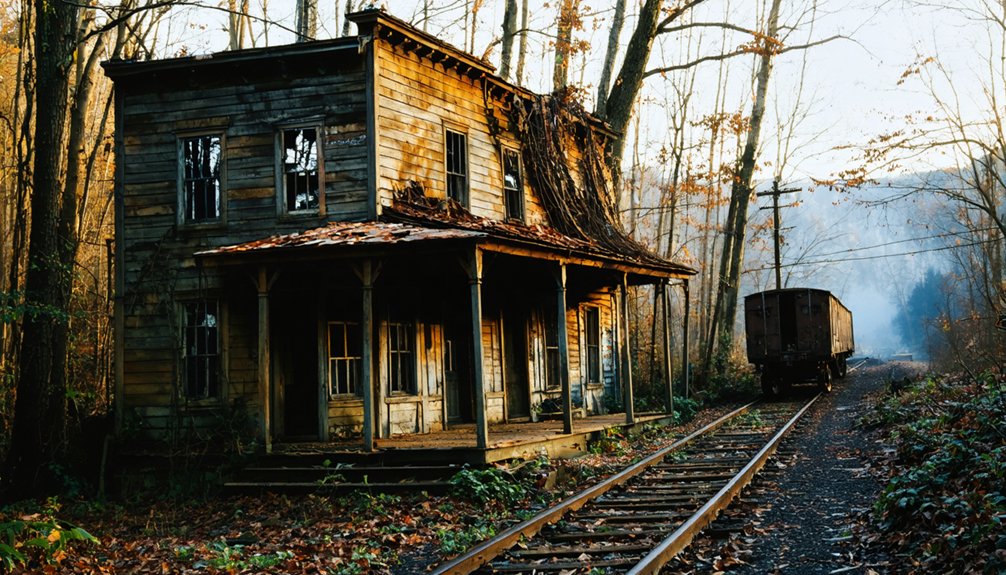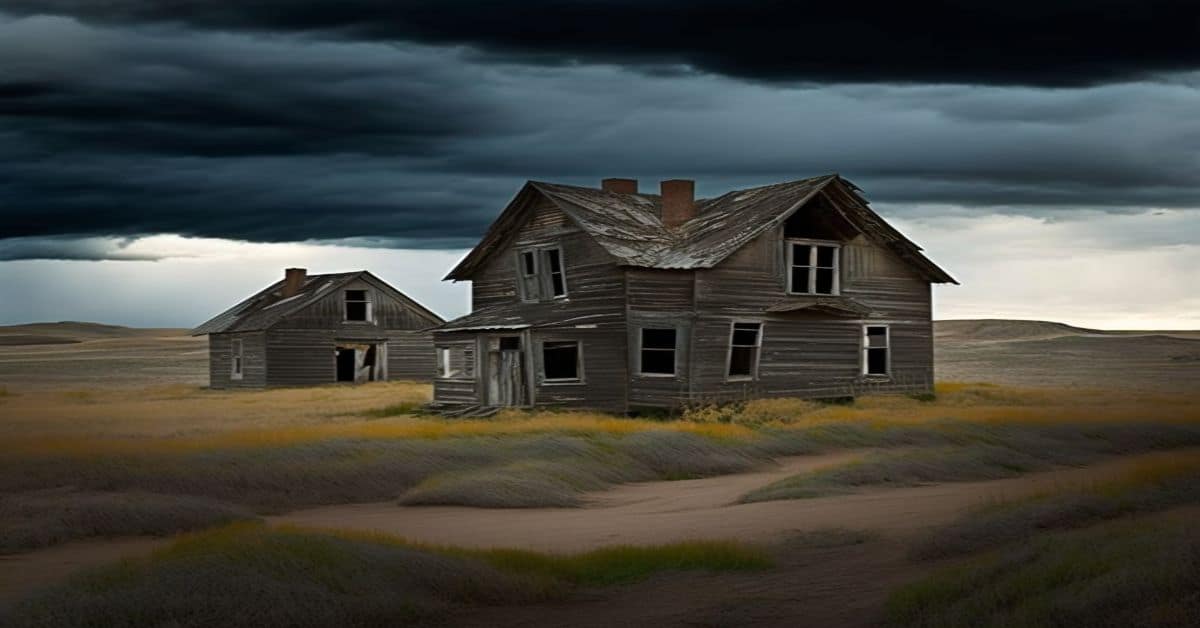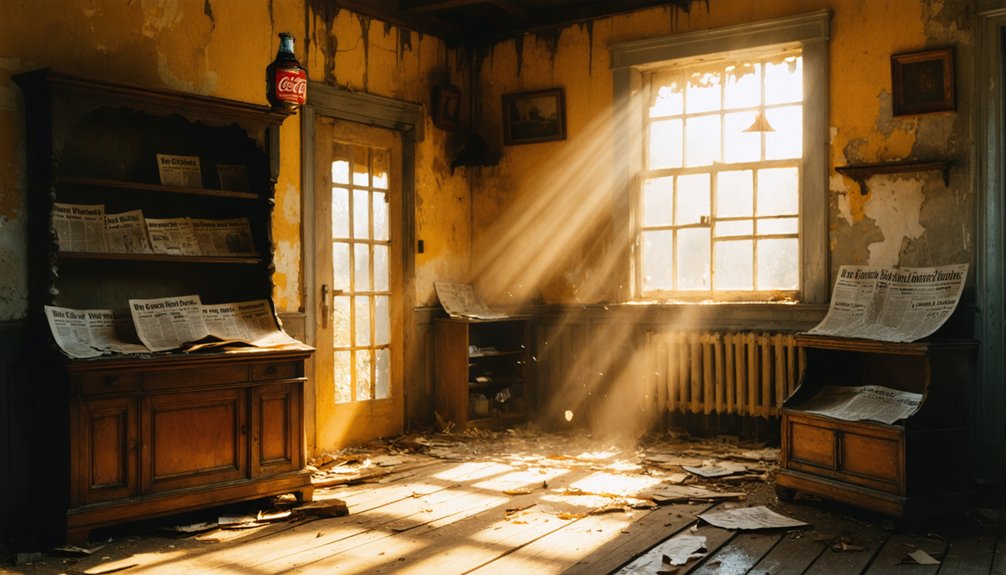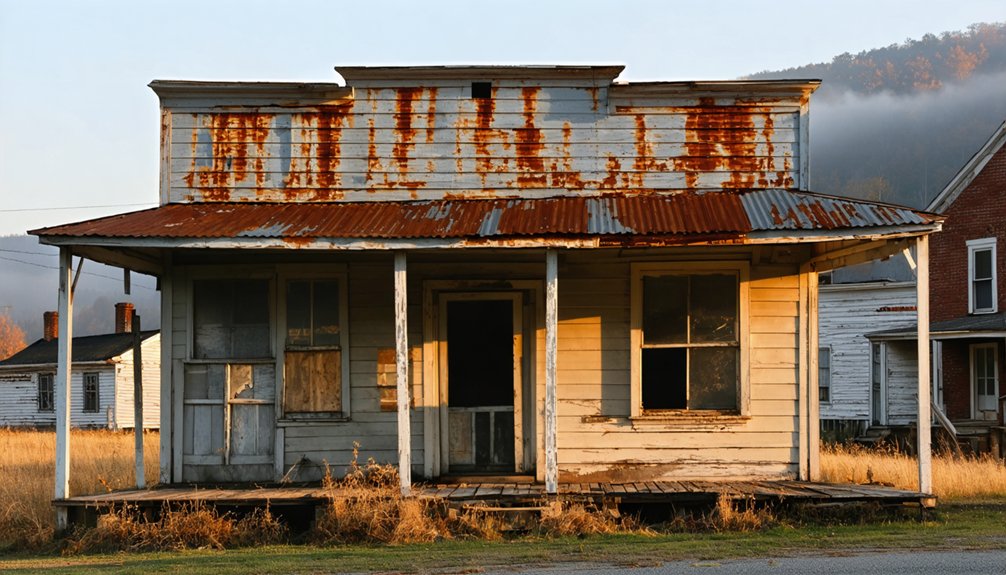You’ll discover a remarkably preserved ghost town in McCreary County, Kentucky, where J.S. Stearns established the state’s first coal mining settlement in 1902. Barthell thrived with 41 company homes, a bustling company store, and essential community buildings until a devastating fire in 1943 marked its decline. By 1961, this once-vibrant mining town stood abandoned. Today, restored company homes and original mining artifacts offer an authentic window into Appalachian coal camp life.
Key Takeaways
- Barthell was Kentucky’s first coal mining settlement, established in 1902 by J.S. Stearns in McCreary County.
- The town thrived with 41 company homes, stores, schools, and mining operations until a devastating fire in 1943 sparked decline.
- Complete abandonment occurred by 1961, transforming Barthell into a ghost town after coal operations shifted to Blue Heron.
- In 1984, Barthell was revived as a living history museum, offering restored company homes for overnight stays.
- Visitors can explore original buildings and mining artifacts, experiencing authentic coal camp life from the early 1900s.
The Birth of a Coal Mining Community
When J.S. Stearns established Barthell Coal Camp in 1902, you’d have witnessed the birth of Kentucky’s pioneering coal mining settlement. As the first camp of its kind in McCreary County, it set the stage for a thriving industrial revolution in the region.
You would’ve seen the rapid development of community infrastructure, from miners’ homes to essential facilities, all carefully planned to support the growing workforce. Regular monitoring of resources helped maintain the camp’s operational efficiency and prevented disruptions to mining activities. Today, visitors can explore these well-preserved buildings that offer an authentic glimpse into early 1900s mining life.
The camp wasn’t just about extracting coal – it represented the foundation of a new way of life. Under the operation of Stearns Coal and Lumber Company, Barthell quickly evolved into a self-sustaining community where mining technology and daily life intertwined.
Barthell Coal Camp transcended mining operations, creating a vibrant community where industrial progress and everyday living merged seamlessly.
The camp’s strategic location and well-organized layout helped establish it as the blueprint for future mining settlements throughout Kentucky’s coal country.
Life in the Mining Camp
As a miner in Barthell, you’d start your day with a long, dangerous shift underground, operating hand loaders until mechanization arrived in the 1950s.
Your family’s social life revolved around the company store, where you’d spend your scrip on supplies while catching up with neighbors and sharing news.
When you weren’t working, you might join other families for school events, holiday celebrations, or informal gatherings that helped strengthen the tight-knit bonds of your isolated mining community.
You could seek medical attention at the Doctor’s Office that served the camp’s residents.
After your shift, you’d head to the Bath House to clean up and change out of your coal-dusted work clothes.
Daily Work Routines
Life in Barthell’s mining camp revolved around the harsh demands of coal extraction, where miners endured grueling 10-12 hour shifts six days a week.
You’d start your day before dawn, gathering your tools and carbide lamp for the dangerous descent into the dark tunnels. Safety measures were minimal – just a quick equipment check before you’d venture underground. The mine was owned and operated by Stearns Coal and Lumber Co., which controlled every aspect of the workers’ lives.
Throughout your shifts, you’d work in cramped, poorly ventilated spaces, swinging pick axes and shovels to extract coal from narrow seams. You’d load coal cars by hand, earning a mere 60 cents per ton. Today, visitors can explore 300 feet into mine to experience these conditions firsthand.
The company’s strict rules meant you couldn’t be late, and with your home tied to your job, you’d push through exhaustion and hazardous conditions.
After sunset, you’d emerge coal-covered, clean up in the company bathhouse, and return to your modest company-owned house.
Social Activities and Recreation
The rhythmic twang of banjos and fiddles often pierced through Barthell’s evening air, offering miners a welcome respite from their grueling work schedules.
You’d find families gathering in communal halls for dances, picnics, and holiday celebrations that strengthened community bonding throughout the coal camp. The company store served as a central hub where you could join card games or share stories with fellow miners.
Children created their own adventures, playing makeshift games near their homes while adults enjoyed leisure activities like hiking in the surrounding wilderness.
The church wasn’t just for Sunday services – it became a cornerstone of social life, hosting events that brought together diverse cultural traditions from both immigrant and local Appalachian families.
These gatherings, filled with music and storytelling, helped preserve the rich heritage that you can still experience today through guided tours and reenactments. Visitors can now take short mine tours to better understand the challenging lives these coal mining families endured.
Growth and Peak Years
Following its 1902 establishment, Barthell experienced rapid growth driven by the booming coal industry of Appalachia. By 1903, you’d have seen the first coal shipments leaving town, marking the beginning of significant economic impact on the region.
By 1903, Barthell’s coal shipments marked the start of an economic transformation that would reshape Appalachia’s industrial landscape.
The Stearns Coal and Lumber Company’s investment in community development transformed the area from wilderness into a thriving mining camp. Like Blue Heron Mine 18, it became a vital part of Kentucky’s mining heritage.
Within just seven years, you’d have found 41 company-owned homes and essential facilities dotting the landscape. The town’s infrastructure expanded to include Store Number Two, one of 18 company stores in the region, along with a motor house, bath house, tipple, school, and post office.
These developments supported a growing population of miners and their families, making Barthell the cornerstone of McCreary County‘s early coal operations. Today, the haunted coal town stands as a testament to Kentucky’s rich mining history.
The Great Fire and Economic Downturn
Prosperity in Barthell came to an abrupt halt when flames engulfed Mine No. 1‘s tipple on June 17, 1943.
In the fire’s aftermath, you’d have witnessed the immediate closure of Mine No. 1, forcing miners to reroute coal production to the Blue Heron complex’s Mine No. 18. Despite the community’s resilience during wartime production demands, Stearns Coal & Lumber Company chose not to rebuild.
The devastating fire marked the beginning of Barthell’s decline.
You would’ve seen the gradual exodus of families as the company began dismantling the coal camp in 1952. While Mine No. 2 continued operations for a time, the lack of investment and modernization sealed the town’s fate.
From Bustling Town to Abandonment
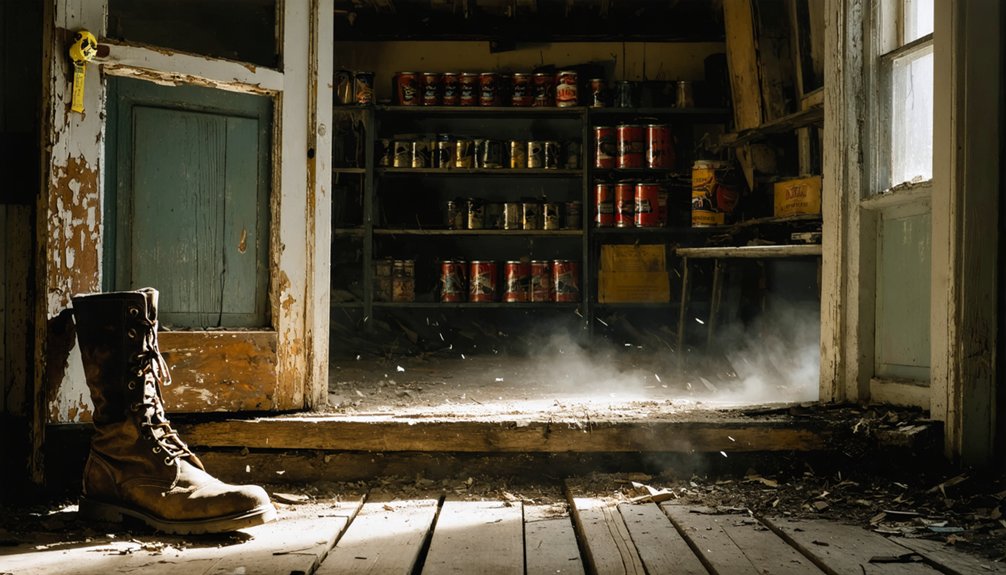
You’ll find it hard to imagine that Barthell once bustled with 350 residents spread across 41 dwellings, complete with a company store, schoolhouse, and essential services that marked it as a thriving coal camp community.
When Mine No. 1‘s tipple burned down in 1943, the town’s decline accelerated rapidly, forcing operations to redirect to Mine No. 2 and the Blue Heron complex.
Like its neighbor Blue Heron camp, which housed 300 miners and their families, Barthell represented a significant part of Kentucky’s coal mining heritage.
Rise and Peak Years
When Barthell emerged in 1902 as Stearns’ first mining camp, it quickly transformed into a bustling industrial hub. Under L.E. Bryant’s supervision and James Bonnyman’s leadership, the town’s community development flourished.
By 1903, you’d have found a complete industrial operation with the arrival of the K&T Railroad enabling economic integration throughout the region.
- The town boasted essential infrastructure including a coal tipple, schools, and supervisor housing
- Regular railroad excursions brought visitors and commerce to the growing community
- Annual July 4th celebrations became a cherished tradition starting in 1903
Despite a tragic mine explosion in 1904 that claimed five lives, Barthell’s resilience showed through its diversified economy.
Both coal mining and lumber operations thrived, with the sawmill’s opening in 1903 providing additional employment opportunities beyond the mines.
Decline and Final Days
The devastating fire that destroyed Barthell’s No. 1 Mine tipple in 1943 marked the beginning of the town’s irreversible decline.
Despite showing remarkable community resilience during the Great Depression, even setting a coal production record in 1930, Barthell couldn’t overcome this critical infrastructure loss.
While Mine No. 2 continued operations, the economic impact rippled through the community as coal processing shifted to the Blue Heron complex.
You’d have witnessed the town’s gradual unraveling as families sought opportunities elsewhere.
Post-World War II brought decreased coal demand nationwide, further straining Barthell’s survival.
By 1952, the once-bustling coal camp began dismantling, with empty homes and abandoned buildings telling the story of its fading glory.
The process continued until 1961, leaving behind a ghost town in McCreary County’s remote hills.
Modern-Day Heritage Tourism
Since its revival in 1984, Barthell has transformed from an abandoned coal mining settlement into a living history museum that showcases early 20th-century coal camp life.
Through heritage preservation efforts, you’ll find restored company homes where you can spend the night, experiencing authentic coal camp living firsthand. This unique destination now contributes to McCreary County’s economic impact through heritage tourism, drawing history enthusiasts and outdoor adventurers alike.
- Explore original buildings and mining artifacts in their natural setting
- Stay overnight in authentically renovated historic company houses
- Combine your visit with trips to nearby attractions like the Big South Fork National River and Blue Heron Mining Community
The site’s integration with regional attractions creates a thorough heritage tourism experience, connecting you to Kentucky’s rich coal mining history while supporting local businesses and preserving cultural assets for future generations.
Frequently Asked Questions
Are There Any Reported Ghost Sightings or Paranormal Activities in Barthell?
You won’t find documented ghostly encounters in official records, though local folklore mentions miners’ spirits. No legitimate paranormal investigations have confirmed supernatural activity, leaving only unverified regional stories and anecdotes.
What Happened to the Original Residents After Leaving Barthell?
You’ll find that life after Barthell scattered residents to nearby mining towns and urban centers. They left behind their homes, their jobs, and their tight-knit community, seeking new opportunities across McCreary County.
Can Visitors Stay Overnight in Any Reconstructed Buildings?
Yes, you can stay overnight in 12 reconstructed Company Houses at Barthell, featuring modern amenities while preserving historic authenticity. They offer nine two-bedroom and three one-bedroom accommodations for up to four guests each.
Were There Any Major Mining Accidents During Barthell’s Operational Years?
Like a bad Instagram story, mining safety records aren’t complete, but you’ll find documentation of a significant 1937 accident and a devastating 1945 tipple fire in accident reports from Barthell’s operations.
What Artifacts From the Original Town Have Been Preserved?
You’ll find preserved company buildings like the doctor’s office, barber shop, and bathhouse, alongside mining tools and household items. These preservation efforts maintain Barthell’s historical significance as a coal camp.
References
- https://eec.ky.gov/Natural-Resources/Mining/Abandoned-Mine-Lands/projects/Pages/Big_South_Fork.aspx
- https://www.freakyfoottours.com/us/kentucky/
- http://www.coaleducation.org/coalhistory/coaltowns/barthell.htm
- http://freepages.rootsweb.com/~gtusa/history/usa/ky.htm
- https://www.kentuckytourism.com/things-to-do/outdoors/natural-attractions/big-south-fork/articles/2024/09/12/delightfully-spooky-kentucky
- https://www.oklahoman.com/story/news/2009/10/28/ghost-town-in-kentucky-has-a-lively-history/61337332007/
- https://www.barthellcoalcamp.com/history/timeline.htm
- https://evendo.com/locations/kentucky/big-south-fork-national-river-and-recreation-area/attraction/barthell-coal-camp
- https://www1.lanereport.com/64408/2016/06/restored-coal-camp-pays-homage-to-hard-working-miners-of-yesteryear/
- https://www.youtube.com/watch?v=HmqMbW-L6M8
